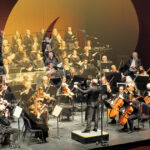Concert Review: Mahler Symphony No. 2, September 15, 2012
This review appeared in the Albuquerque Journal. Reprinted with kind permission.
by D.S. Crafts
Alive and thriving the New Mexico Philharmonic pulled out all stops to begin its new season on Saturday night with as large an orchestra and chorus as could be accommodated on the stage of Popejoy Auditorium. Tackling the sonically enormous Mahler’s Symphony No. 2 “Resurrection,” a challenge for any orchestra, the Philharmonic is to be applauded for programming beyond the too often tried and true repertoire. Especially, in this case where the number of players required is formidable.
A sprawling canvas of an apocalyptic vision, it is cast in five sections, including two vocal soloists and chorus, the outer section running in the neighborhood of twenty and thirty minutes respectively. As to whether content justifies length, the jury is still out. There are, for example, long stretches in the last movement where very little is happening.
But there was no question regarding quality of performance Saturday night. Guest conductor Uriel Segal led the huge forces with a clear vision, balancing the sound and fury of the massive and tenebrous bookend movements with the more cheerful moods—though “cheerful” in relation to Mahler takes on severe limitations. The few spots of less than perfect intonation was likely due to the number of “ringers” in addition to the core ensemble, brought in to fill out the parts.
Mahler claimed that the inspiration for this complex composition came to him at the funeral of another conductor who died suddenly. There is clearly a dramatic program, though Mahler was loath to reveal it publicly. Essentially, the protagonist is standing by the coffin of a beloved friend questioning the meaning of life and the possibility of afterlife.
The happy memory of youth and lost innocence in the form of a minuet invokes an earlier period of music. Light, grace and ease of execution marked the Andante moderato.
The third movement scherzo is an expression of futility cast in a deceptive shell, being closely related to Mahler’s song about St. Anthony preaching to the fishes that listen to his sermon then swim away as though it had never happened. The movement contains only the music, not the words of the song, but the ironic effect was felt just the same as the initial frolicking tone turns deeply bitter.
Without pause Susan Platts stepped into the intimate (Primal Light) movement, with its brass chorale, singing a text from the collection of folk poetry Des Knaben Wunderhorn to which Mahler would later turn frequently. Though listed as a mezzo Platts pure tone was richly contralto, illuminating the words with a golden sound that proved the highlight of the entire work. More of her please!
Sing again she did in the final section along with soprano Paulette Berman Fagen rising above the patiently waiting chorus who had remained onstage throughout. Here the earth trembles and the dead rise from their tombs, marching in procession toward some terrible Last Judgment. But in the end all is peaceful tranquility as the excellent New Mexico Symphonic Chorus entered as softly as a 70-some voiced choir can sing, then rising to a formidable climax at work’s end.




